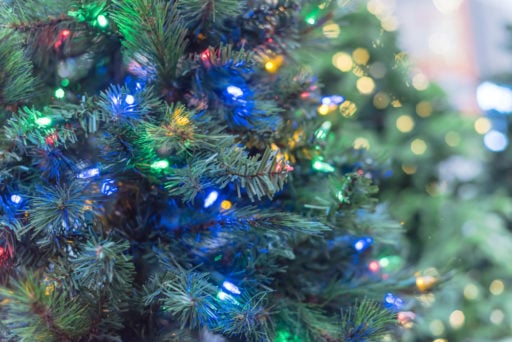
We think you'll agree that lighting really completes a Christmas tree. Tinsel, ornaments, garland, and baubles are all well and good, but it’s the lights that make a Christmas tree truly shine.
But not everyone wants the hassle of stringing lights year on year! That's where pre-lit options come in.
By choosing a tree with built-in lighting, such as a pre-lit or fibre optic Christmas tree, you can save time and effort when decorating. Which means more time for festive fun!
Our guide covers everything you need to know about fibre optic and pre-lit Christmas trees, making it easy for you to choose the perfect tree for your home.
What is a pre-lit Christmas tree?
A pre-lit Christmas tree is an artificial tree that comes with lights already attached to the branches, making it a convenient and time-saving option for decorating during the festive season.
The lights are also professionally strung, ensuring they’re placed in just the right spots to achieve perfect, even coverage. This means no more wrestling with tangled strings of lights or dealing with dark spots on your tree.
Pre-lit trees are available in various styles, with options for bright white, warm white, or multicolour lights. These trees are ideal for those who want a traditional look without the hassle of stringing lights every year.
The pros of pre-lit Christmas trees
- Traditional look: Pre-lit Christmas trees often mimic the appearance of a real tree, making them a great choice for those who love classic Christmas décor.
- Easy setup: With lights already in place, these trees are simple to set up, take down, and store.
- Energy efficient: Many pre-lit trees use LED technology, which is more energy efficient than traditional incandescent bulbs.
- Professionally strung: The lights are strategically woven throughout the branches, creating a balanced, uniform glow that highlights the tree’s natural beauty.
- Variety of lighting options: Pre-lit trees offer a wide range of lighting options, including adjustable brightness and colour settings. You can also choose to add more lights on top of the professionally strung ones that come on the tree.
The cons of pre-lit Christmas trees
- Higher cost: Pre-lit Christmas trees can be more expensive than unlit options.
- Less choice: With a pre-lit Christmas tree, you have less choice over where the lights go, as they are already installed.
What is a fibre optic Christmas tree?
Technically, fibre optic trees are a type of pre-lit Christmas tree—that is, they come with the lights (or lighting ability) already built into the tree.
Where a fibre optic Christmas tree differs is that it uses fibre optic technology to create a stunning twinkling effect. Unlike traditional pre-lit Christmas trees, which have visible lights on the branches, a fibre optic tree emits light throughout the tree, creating an ethereal and mesmerising look.
Fibre optic trees are often found in a variety of colours, adding a unique twist to traditional Christmas décor. They’re a great option if you’re looking for a low-maintenance modern Christmas tree.
The pros of fibre optic Christmas trees
- Unique lighting effect: The glowing effect of a fibre optic tree adds a magical ambience to any room that can’t be replicated with standard LEDs.
- Energy efficiency: Like pre-lit trees, fibre optic Christmas trees are also energy efficient, often using LED lights for illumination.
- Low maintenance: These trees are generally low maintenance, as the lights are built into the tree, reducing the need for replacement bulbs.
The cons of fibre optic Christmas trees
- Less traditional appearance: A fibre optic tree may not resemble a real tree as closely as a pre-lit tree does.
- Non-removable lights: The lighting is built into the tree, meaning you can’t remove or replace the lights if they stop working.(Although warranty usually covers fibre optics in the event that they are faulty.)
The main differences between pre-lit trees and fibre optic trees
When deciding between a pre-lit vs fibre optic Christmas tree, it’s essential to consider several factors:
Lighting
Pre-lit Christmas trees feature visible lights strung along the branches, while fibre optic Christmas trees offer a more integrated lighting effect, with light emanating from the entire tree.
Both options can create a festive atmosphere, but the style of lighting differs significantly.
Cost
Generally, both pre-lit and fibre optic Christmas trees tend to be more expensive than unlit artificial trees.
However, the added convenience and lighting effects can justify the cost, especially if you’re looking for a low-maintenance option that saves time during the busy festive season.
Maintenance
Pre-lit trees might require occasional bulb replacements, whereas fibre optic trees are low-maintenance. Their lights are built into the tree's structure, reducing the need for upkeep.
Setup
Pre-lit Christmas trees are straightforward to set up, as the lights are already attached to the branches. Fibre optic Christmas trees are equally easy, with no need to untangle strings of lights.
Both types offer convenience, but the setup process may vary slightly depending on the specific tree.
Find your perfect artificial Christmas tree with Christmas Tree World
Choosing the right artificial Christmas tree is more than just picking out a seasonal decoration—it's about finding the centrepiece that will bring warmth and festive cheer to your home year after year.
At Christmas Tree World, we offer a wide range of pre lit and fibre optic Christmas trees designed to suit every style and preference. Whether you’re looking for the classic beauty of a pre-lit tree or the magical glowing effect of a fibre optic tree, we have something for everyone.
With quality, convenience, and beauty in mind, Christmas Tree World ensures that you’ll find a tree that you and your family will love for years to come. Browse our range today and see for yourself why so many people trust us to light up their festive season.
FAQs
Should you get a pre-lit or unlit Christmas tree?
It comes down to how much time you want to spend on decorating. If you love the idea of customising your tree with your own lights and creating a different look every year, then an unlit tree might be the way to go.
But if you’d rather skip the hassle of untangling strings of lights and just want a tree that’s ready to shine as soon as you set it up, a pre-lit tree is a fantastic choice. You can always add your own lights on top for some extra razzle dazzle!
Are fibre optic Christmas trees expensive to run?
No, fibre optic Christmas trees are generally inexpensive to run. They often use LED technology, which is more energy-efficient than traditional lighting.










